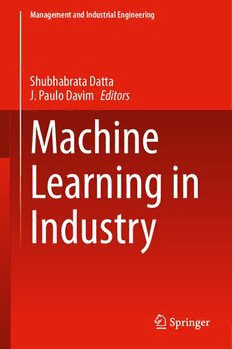Table Of ContentManagement and Industrial Engineering
Shubhabrata Datta
J. Paulo Davim Editors
Machine
Learning in
Industry
Management and Industrial Engineering
SeriesEditor
J.PauloDavim,DepartmentofMechanicalEngineering,UniversityofAveiro,
Aveiro,Portugal
This series fosters information exchange and discussion on management and
industrial engineering and related aspects, namely global management, organiza-
tional development and change, strategic management, lean production, perfor-
mance management, production management, quality engineering, maintenance
management, productivity improvement, materials management, human resource
management, workforce behavior, innovation and change, technological and
organizational flexibility, self-directed work teams, knowledge management,
organizational learning, learning organizations, entrepreneurship, sustainable
management, etc. The series provides discussion and the exchange of information
on principles, strategies, models, techniques, methodologies and applications of
management and industrial engineering in the field of the different types of
organizational activities. It aims to communicate the latest developments and
thinkinginwhatconcernsthelatestresearchactivityrelatingtoneworganizational
challengesandchangesworld-wide.Contributionstothisbookseriesarewelcome
on all subjects related with management and industrial engineering. To submit a
proposal or request further information, please contact Professor J. Paulo Davim,
BookSeriesEditor,[email protected]
Moreinformationaboutthisseriesathttp://www.springer.com/series/11690
·
Shubhabrata Datta J. Paulo Davim
Editors
Machine Learning in Industry
Editors
ShubhabrataDatta J.PauloDavim
DepartmentofMechanicalEngineering DepartmentofMechanicalEngineering
SRMInstituteofScienceandTechnology UniversityofAveiro
Chennai,TamilNadu,India Aveiro,Portugal
ISSN2365-0532 ISSN2365-0540 (electronic)
ManagementandIndustrialEngineering
ISBN978-3-030-75846-2 ISBN978-3-030-75847-9 (eBook)
https://doi.org/10.1007/978-3-030-75847-9
©TheEditor(s)(ifapplicable)andTheAuthor(s),underexclusivelicensetoSpringerNature
SwitzerlandAG2022
Thisworkissubjecttocopyright.AllrightsaresolelyandexclusivelylicensedbythePublisher,whether
thewholeorpartofthematerialisconcerned,specificallytherightsoftranslation,reprinting,reuse
ofillustrations,recitation,broadcasting,reproductiononmicrofilmsorinanyotherphysicalway,and
transmissionorinformationstorageandretrieval,electronicadaptation,computersoftware,orbysimilar
ordissimilarmethodologynowknownorhereafterdeveloped.
Theuseofgeneraldescriptivenames,registerednames,trademarks,servicemarks,etc.inthispublication
doesnotimply,evenintheabsenceofaspecificstatement,thatsuchnamesareexemptfromtherelevant
protectivelawsandregulationsandthereforefreeforgeneraluse.
Thepublisher,theauthorsandtheeditorsaresafetoassumethattheadviceandinformationinthisbook
arebelievedtobetrueandaccurateatthedateofpublication.Neitherthepublishernortheauthorsor
theeditorsgiveawarranty,expressedorimplied,withrespecttothematerialcontainedhereinorforany
errorsoromissionsthatmayhavebeenmade.Thepublisherremainsneutralwithregardtojurisdictional
claimsinpublishedmapsandinstitutionalaffiliations.
ThisSpringerimprintispublishedbytheregisteredcompanySpringerNatureSwitzerlandAG
Theregisteredcompanyaddressis:Gewerbestrasse11,6330Cham,Switzerland
Preface
Machinelearning(ML)isamethodfortrainingcomputersormakingthecomputer
learn automatically from the supplied information or data. Different methods of
machine learning originate from the nature and follow the principle of biological
learning.TheapplicationsofMLintherealworldareincreasingfastandencompass
ourdailylifewithoutourknowledge.Themanufacturingandotherindustrialsectors
have also started using the ML in their plants effectively. With the advent of the
conceptofIndustry4.0,thepaceofapplicationofMLincoreindustrieswillonly
increase.
The introductory chapter of this book describes the basic concepts of the most
populartechniquesofmachinelearning.Itexplainsthedifferentclassesofmachine
learning approaches and describes the statistical and artificial intelligence-based
machinelearningtechniquesinbrief.Thetechniqueslikedecisiontree,linearregres-
sion,leastsquaremethod,artificialneuralnetwork,clusteringtechniques,anddeep
learningarediscussed.
Practicalexamplesofapplicationsandcasestudiesusingpracticalindustrialprob-
lemsorproblemsrelevanttotheindustriesaredescribedintherestofthechapters,
i.e.,ChaptersNeuralNetworkModelIdentificationStudiestoPredictResidualStress
ofaSteelPlateBasedonaNon-destructiveBarkhausenNoiseMeasurement–Perfor-
manceImprovementinHotRollingProcesswithNovelNeuralArchitecturalSearch.
In the Chapter Neural Network Model Identification Studies to Predict Residual
Stress of a Steel Plate Based on a Non-destructive Barkhausen Noise Measure-
ment,aML-basedprocedureusingartificialneuralnetworkandgeneticalgorithmis
proposedforpredictingtheresidualstressinsteel.ChapterDataDrivenOptimiza-
tionofBlastFurnaceIronMakingProcessUsingEvolutionaryDeepLearningdeals
with modeling the complicated process of iron and steel making. Parameters like
burdendistribution,oxygenenrichment,productivityimprovement,compositionof
thetopgas,andmanyotherparametersinblastfurnacecontroltheproductivityina
complexway.Inthischapter,machinelearningapproachesareemployedtomodel
theblastfurnaceprocessandevolutionaryalgorithmsareemployedtooptimizethe
process.
In the Chapter A Brief Appraisal of Machine Learning in Industrial Sensing
Probes,theauthordescribesthemethodtoimplementMLinthedigitalcontroland
v
vi Preface
monitoring systems in industries. How the sensors can be used effectively for the
integrationofindustrialdataforstandardMLisdiscussed.TheapplicationofML
for searching the root cause of sliver defects in the cold rolling mill is described
intheChapterMiningtheGenesisofSliverDefectsThroughRoughandFuzzySet
Theories.Atypicalcaseisdescribedwherethegenesisofthedefectisanalyzedusing
twomethods,viz.roughsetandfuzzysettheories.Thischaptershowshowtherough
settheorycanbeusedtoselecttheimportantvariablestowhichthecauseofthedefect
canbeattributed.Therulescreatedfromthedataareusedinthefuzzyframework
fordevelopingapredictivemodel.AnoverviewoftheapplicationofMLmethods
in the field of materials science with respect to materials—processes—knowledge
formalization is provided in the Chapter Machine Learning Studies in Materials
Science.
ML can be used for developing surrogate models or metamodels, which can
replace complex analytical models and numerical simulations for optimization,
sensitivityanalysisanduncertaintyquantification.InChapterAccurate,Real-Time
Replication of Governing Equations of Physical Systems with Transpose CNNs
—forIndustry4.0andDigitalTwins,Convolutional-NN-likearchitecturesareused
assurrogatemodelsontwodifferentapplicationsofreducedNavier–Stokesequations
containinghighnonlinearitiesandabruptdiscontinuities.
Deep learning is the latest paradigm of machine learning. The Chapter Deep
LearninginVision-BasedAutomatedInspection:CurrentStateandFutureProspects
ofthebookevaluatestheapplicationofthetechniquesforvision-basedautomated
inspection.Hereadetailed discussiononthemeritsand demeritsof deep learning
for automated inspection tasks in industries are made. The ninth and last chapter
proposes a novel algorithm to design multi-layered feed forward neural networks
withparsimonyaswellasaccuracyusingmulti-objectiveoptimization.
It is quite evident that the authors of the present book covered various aspects
and applications of machine learning relevant to the industry. The editors express
their sincere gratitude to the authors for their excellent contributions. The editors
also express their thanks to all the reviewers who have contributed immensely to
theimprovementofthequalityofthechapters.Boththeeditorsaregratefultotheir
colleagues,friends,andfamilymembers.TheeditorsalsoacknowledgetheSpringer
teamfortheirexcellentworktowardsshapingthecompilationbeautifully.
Chennai,India ShubhabrataDatta
Aveiro,Portugal J.PauloDavim
Contents
FundamentalsofMachineLearning ................................. 1
A.VinothandShubhabrataDatta
NeuralNetworkModelIdentificationStudiestoPredictResidual
StressofaSteelPlateBasedonaNon-destructiveBarkhausen
NoiseMeasurement ................................................ 29
TeroVuolio,OlliPesonen,AkiSorsa,andSuviSanta-aho
Data-DrivenOptimizationofBlastFurnaceIronMakingProcess
UsingEvolutionaryDeepLearning .................................. 47
BashistaKumarMahanta,RajeshJha,andNirupamChakraborti
ABriefAppraisalofMachineLearninginIndustrialSensingProbes ... 83
R.Biswas
MiningtheGenesisofSliverDefectsThroughRoughandFuzzy
SetTheories ...................................................... 97
ItishreeMohanty,ParthaDey,andShubhabrataDatta
MachineLearningStudiesinMaterialsScience ...................... 121
BarbaraMrzygłód,KrzysztofRegulski,andAndrzejOpalin´ski
Accurate, Real-Time Replication of Governing Equations
ofPhysicalSystemswithTransposeCNNs—forIndustry4.0
andDigitalTwins .................................................. 139
HritikNarayanandAryaK.Bhattacharya
DeepLearninginVision-BasedAutomatedInspection:Current
StateandFutureProspects ......................................... 159
R.Senthilnathan
Performance Improvement inHotRollingProcesswithNovel
NeuralArchitecturalSearch ........................................ 177
SrinivasSoumitriMiriyala,ItishreeMohanty,andKishalayMitra
vii
About the Editors
ShubhabrataDatta presentlyaResearchProfessorintheDepartmentofMechan-
icalEngineering,SRMInstituteofScienceandTechnology,Chennai,India,didhis
Bachelors,Masters,andPh.D.inEngineeringfromIndianInstituteofEngineering
ScienceandTechnology,Shibpur,India(previouslyknownasB.E.CollegeShibpur)
inthefieldofMetallurgicalandMaterialsEngineering.Dr.Dattahasmorethan28
yearsofteachingandresearchexperience.Hisresearchinterestisinthedomainof
designofmaterialsusingartificialintelligenceandmachinelearningtechniques.He
wasbestowedwiththeExchangeScientistAwardfromtheRoyalAcademyofEngi-
neering, UK and worked in the University of Sheffield, UK. He also worked in
theDeptofMaterialsScienceandEngineering,HelsinkiUniversityofTechnology,
Finland,DeptofMaterialsScienceandEngineering,IowaStateUniversity,Ames,
USA, and Heat Engineering Lab, Dept of Chemical Engineering, Åbo Akademi
University,FinlandasVisitingScientist.HeisaFellowofInstitutionofEngineers
(India), Associate Editor, Journal of the Institution of Engineers (India): Series D,
andeditorialboardmemberofseveralinternationaljournals.
J.PauloDavim received his Ph.D. degree in Mechanical Engineering in 1997,
M.Sc. degree in Mechanical Engineering (materials and manufacturing processes)
in1991,MechanicalEngineeringdegree(5years)in1986,fromtheUniversityof
Porto(FEUP),theAggregatetitle(FullHabilitation)fromtheUniversityofCoimbra
in2005andtheD.Sc.fromLondonMetropolitanUniversityin2013.HeisSenior
Chartered Engineer by the Portuguese Institution of Engineers with an MBA and
Specialist title in Engineering and Industrial Management. He is also Eur Ing by
FEANI-BrusselsandFellow(FIET)byIET-London.Currently,heisaProfessorat
theDepartmentofMechanicalEngineeringoftheUniversityofAveiro,Portugal.He
hasmorethan30yearsofteachingandresearchexperienceinManufacturing,Mate-
rials,Mechanical,andIndustrialEngineering,withspecialemphasisinMachining&
Tribology.HealsohasinterestinManagement,EngineeringEducation,andHigher
Education for Sustainability. He has guided large numbers of postdoc, Ph.D., and
master’s students as well as has coordinated and participated in several financed
researchprojects.Hehasreceivedseveralscientificawards.Hehasworkedasevalu-
atorofprojectsforERC-EuropeanResearchCouncilandotherinternationalresearch
ix
x AbouttheEditors
agenciesaswellasexaminerofPh.D.thesisformanyuniversitiesindifferentcoun-
tries.HeistheEditorinChiefofseveralinternationaljournals,GuestEditorofjour-
nals,bookEditor,bookSeriesEditor,andScientificAdvisoryformanyinternational
journalsandconferences.

